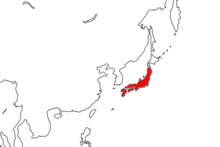
Back Cynops pyrrhogaster AN نيوت بطن النار اليابانى ARZ Yapon yanğın qarın tritonu Azerbaijani Огненокоремен тритон Bulgarian Cynops pyrrhogaster CEB Japanischer Feuerbauchmolch German Cynops pyrrhogaster Spanish Cynops pyrrhogaster Basque سمندرک شکمآتشی ژاپنی Persian Japanintulilisko Finnish
| Japanese fire-bellied newt Temporal range: Middle Miocene – Present
| |
|---|---|

| |
| Female Japanese fire-bellied newt | |
| Scientific classification | |
| Domain: | Eukaryota |
| Kingdom: | Animalia |
| Phylum: | Chordata |
| Class: | Amphibia |
| Order: | Urodela |
| Family: | Salamandridae |
| Genus: | Cynops |
| Species: | C. pyrrhogaster
|
| Binomial name | |
| Cynops pyrrhogaster (Boie, 1826)
| |

| |
| Synonyms[2] | |
|
Molge pyrrhogaster (Boie, 1826) | |
The Japanese fire-bellied newt or Japanese fire-bellied salamander (Cynops pyrrhogaster) is a species of newt endemic to Japan. The skin on its upper body is dark and its lower regions bright red, although coloration varies with age, genetics, and region. Adults are 8 to 15 cm (3.1 to 5.9 in) long. To deter predators, Japanese fire-bellied newts contain high levels of tetrodotoxin, a neurotoxin accumulated mainly from their diet.
The species is found on many Japanese islands, including Honshu, Shikoku, and Kyushu. Their habitats include both natural and artificial bodies of water, as well as forests and grasslands. They breed from spring to the beginning of summer, both sexes producing pheromones when ready to mate. Eggs are laid separately, hatching after about three weeks. They grow from larval to juvenile form in between five and six months. Juveniles eat soil-dwelling prey, and adults eat a wide variety of insects, tadpoles, and the eggs of their own species. They have several adaptations to avoid predators, although which they use depends on where they live. Several aspects of their biology have been studied, including their ability to regrow missing body parts.
The Japanese fire-bellied newt first diverged from its closest relative in the Middle Miocene, before splitting into four distinct varieties, each with a mostly separate range, although all four are formally recognized as composing a single species. Currently, their population is declining, and they face threats from disease and the pet trade. They can be successfully kept in captivity.
- ^ IUCN SSC Amphibian Specialist Group (2021). "Cynops pyrrhogaster". IUCN Red List of Threatened Species. 2021: e.T59444A177224976. doi:10.2305/IUCN.UK.2021-1.RLTS.T59444A177224976.en. Retrieved 12 November 2021.
- ^ Cite error: The named reference
amnhwas invoked but never defined (see the help page).
